The NVIDIA GeForce RTX 2080 Ti & RTX 2080 Founders Edition Review: Foundations For A Ray Traced Future
by Nate Oh on September 19, 2018 5:15 PM EST- Posted in
- GPUs
- Raytrace
- GeForce
- NVIDIA
- DirectX Raytracing
- Turing
- GeForce RTX
Final Fantasy XV (DX11)
Upon arriving to PC earlier this, Final Fantasy XV: Windows Edition was given a graphical overhaul as it was ported over from console, fruits of their successful partnership with NVIDIA, with hardly any hint of the troubles during Final Fantasy XV's original production and development.
In preparation for the launch, Square Enix opted to release a standalone benchmark that they have since updated. Using the Final Fantasy XV standalone benchmark gives us a lengthy standardized sequence to utilize OCAT. Upon release, the standalone benchmark received criticism for performance issues and general bugginess, as well as confusing graphical presets and performance measurement by 'score'. In its original iteration, the graphical settings could not be adjusted, leaving the user to the presets that were tied to resolution and hidden settings such as GameWorks features.
Since then, Square Enix has patched the benchmark with custom graphics settings and bugfixes to be much more accurate in profiling in-game performance and graphical options, though leaving the 'score' measurement. For our testing, we enable or adjust settings to the highest except for NVIDIA-specific features and 'Model LOD', the latter of which is left at standard. Final Fantasy XV also supports HDR, and it will support DLSS at some date.
| Final Fantasy XV | 1920x1080 | 2560x1440 | 3840x2160 |
| Average FPS | 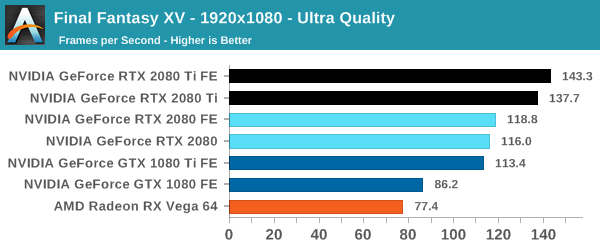 |
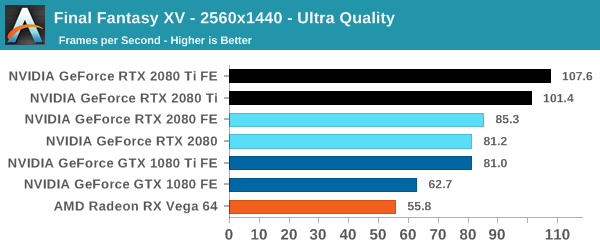 |
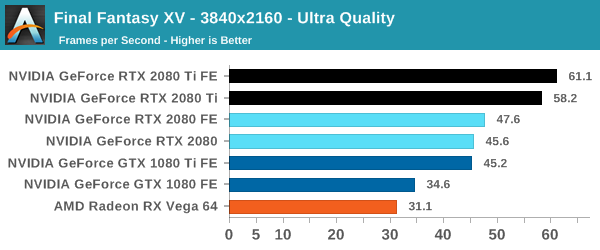 |
| 99th Percentile | 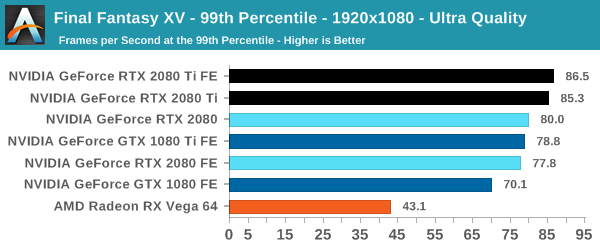 |
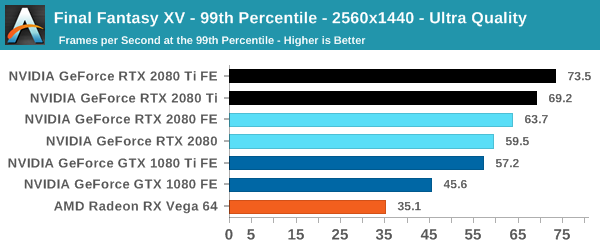 |
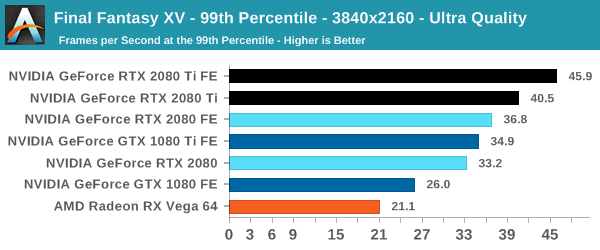 |
NVIDIA, of course, is working closely with Square Enix, and the game is naturally expected to run well on NVIDIA cards in general, but the 1080 Ti truly lives up to its gaming flagship reputation in matching the RTX 2080. With Final Fantasy XV, the Founders Edition power and clocks again prove highly useful in the 2080 FE pipping the 1080 Ti, while the 2080 Ti FE makes it across the psychological 60fps mark at 4K.












337 Comments
View All Comments
Santoval - Wednesday, September 19, 2018 - link
The problem is that it does not bring those things to the current table but is going to bring them to a future table. Essentially they expect you to buy a graphics cards that no current game can support its advanced features merely on faith that it both will deliver them in the future *and* that they will be will be worth the very high premium.If there is one ultimate unwritten rule when buying computers, computer parts or anything really, it must be this one : Never buy anything based on promises of *future* capabilities - always make your purchasing decisions based on what the products you buy can deliver *now*. All experienced computer and console consumers, in particular, must have that maxim engraved on their brain after having been burnt by so many broken promises.
Writer's Block - Monday, October 1, 2018 - link
That is certainly true; 'we promise', politicians and companies selling their shit use it a lot... And break it about as often.Inteli - Wednesday, September 19, 2018 - link
It's not that the price increase wasn't warranted, at least from the transistor count perspective, it's that there's not a lot to show for it.Many more transistors...concentrated in Tensor cores and RTX cores, which aren't being touched in current games. The increased price is for a load of baggage that will take at least a year to really get used (and before you say it, 3 games is not "really getting used"). We're used to new GPUs performing better in current games for the same price, not performing the same in current games for the same price (and I'm absolutely discounting everything before 2008 because that was 10 years ago and the expectations of what a new μArch should bring have changed).
I get the whole "future of gaming" angle you're pushing, and it's a perfectly valid reason to buy these new GPUs, but don't act like an apples-to-apples comparison of performance *right now* is the "wrong way of looking at it". How the card performs right now is an important metric for a lot of people, and will influence their decision. Especially when we're talking a potential price difference of $100+ (with sales on 1080 Ti's, and FE 2080 prices). Obviously there isn't a valid comparison for the 2080 Ti, but anyone who can drop $1300 on a GPU probably doesn't care too much about the price tag.
Flunk - Thursday, September 20, 2018 - link
Nvidia is charging what they are because they have no competition at the top end. That's it, nothing else. They're taking in the cash today in preparation for having to price more competitively later.just4U - Thursday, September 20, 2018 - link
Flunk, we are talking Nvidia here.. typically speaking they don't lower prices to compete.. Sometimes they bump to high and to few bite.. but that's about it. The last time they lowered prices to compete was the 400 series but they'd just come off getting zonked by amd for basically 2 generations.. and when they went to the 500s series it was fairly competitive with amd.. (initially they were better but Amd continued to improve their 5000/6000 series.. til it was consistently beating Nvidia.. did they lower prices? NO.. not one bit..)TNT cards were competitive and cheap.. but once Nvidia knocked off all other contenders (aside from AMD) and started in with their geforce line they have always carried premiums regardless competition or not.
eddman - Thursday, September 20, 2018 - link
GTX 280, launched at $650 because they thought AMD couldn't do much. AMD came up with 4870. What happened? Nvidia cut the card's price to $500 a mere month after launch. So yes, they do cut prices to compete.Dragonstongue - Thursday, September 20, 2018 - link
13.6 and 18.6 (bln transistor estimated) die size of 454/754mm2 (2080/2080Ti) 12nm7.2 and 12 (bln transistor estimated) die size of 314/471 (1070/1080-1080Ti/TitanX) 16nm
yes it is "expensive" no doubt about that, but, it is Nv we are talking about, there is a reason they are way over valued as they are, they produce as cheaply as possible and rack them up in price as much as they can even when their actual cards shipped are no where near the $$$ figure they report as it should.
also, if anything else, they always have and always will BS the numbers to make themselves ALWAYS appear "supreme" no matter if it is actual power used, TDP, API features, or transistor count etc etc etc.
as far as the ray tracing crap...if they used an open source style so that everyone can use the exact same ray tracing engine so they can be directly compared to see how good they are or not then it might be "worthy" but, it is Nv they are and continue to be "it has to be our way or you don't play" type approach...I remember way back when with PhysX (which Nv boug out Ageia to do it) when Radeons were able to use it (before Nv took the ability away) they ran circles around comparable Nv cards AND used less cpu and power to do it.
Nv does not want to get "caught" in their BS, so they find nefarious ways around everything, and when you have a massive amount of $$$$$$$$$$$$$$$$ floating everything you do, it is not hard for them to "buy silence" Intel has done so time and time again, Nv does so time and time again........blekk
DLSS or whatever the fk they want to call it, means jack shit when only specific cards will be able to use it instead of being a truly open source initiative where everyone/everything gets to show how good they are (or not) and also stand to gain benefit from others putting effort into making it as good as it possibly can be...there is a reason why Nv barely supports Vulkan, because they are not "in control" it is way too easy to "prove them wrong"..funny because Vulkan has ray tracing "built in"
IMO if they are as good as they claim they are, they would do everything in the light to show they are "the best" not find ways to "hide" what they are doing.....their days are numbered....hell their stock price just took a hit....good IMHO because they should not be over $200 anyways, $100, maybe, but they absolutely should not be valued above others whos financials and product shipment as magnitudes larger.
Spunjji - Friday, September 21, 2018 - link
Remind me why consumers should give a rats-ass about die size, other than its visible effects of price and performance.If you want to sell me a substantially larger, more expensive chip that performs a little better for a lot more money, a better reason is needed than "maybe it will make some games that aren't out yet really cool in a way that we refuse to give you any performance indications about".
Screw that.
Writer's Block - Monday, October 1, 2018 - link
They look poor value; good performance, sure. But a 1080ti offers the same for much less.They want me to buy promises! Seriously, promises are never worth the paper they are printed on - digital or the real stuff.
Writer's Block - Monday, October 1, 2018 - link
Oh and, yeh agree.